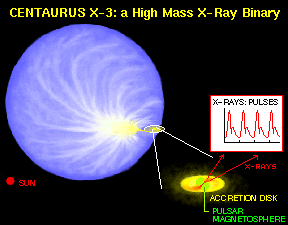Centaurus X-3

Centaurus X-3 is a pulsating X-ray source, roughly 30,000 light-years away in Centaurus, that appears to consist of a pulsar (a neutron star) of mass 0.65 to 0.83 solar masses in orbit around a giant or supergiant B star known as V779 Cen, or Krzeminski's Star (after the Polish astronomer W. Krzeminski). The pulsar spins on its axis once every 4.8 seconds giving rise to regular X-ray variations with this period. It also orbits the giant star every 2.087 days, during which time it is occulted (blocked from our view), so that no X-rays are detected, for 0.488 days. In addition to these variations, the X-ray emission from Cen X-3 flickers at rates of between 100 and 2,000 times per second – the fastest known X-ray variations of any collapsed object in the universe.
This discovery, made using the Rossi X-ray Timing Explorer satellite in 1997, provides strong support for an earlier theory about the X-ray behavior of a neutron star that is part of a binary system. According to this theory, matter sucked off the companion is channeled by the neutron star's intense magnetic field onto the polar caps; moving at one third light-speed, it converts its energy into intense radiation. The rain of hot matter and radiation onto the polar cap of the neutron star is like a super-violent version of Earth's aurorae. The radiation creates a strong pressure near the surface of the neutron star and pushes the infalling matter aside, poking holes in the matter and creating empty bubbles that fill with 100-million-degree radiation. These bubbles of X-ray light, known as photon bubbles, rise like hot fingers to a few kilometers above the surface of the neutron star only to fall and disintegrate, releasing their energy in about a thousandth of a second. Computer simulations predict that the photon bubble fingers release radiation in a more or less regular fashion, causing the neutron star to flicker with a quasiregular period of about a millisecond-exactly as seen in the case of Cen X-3.


